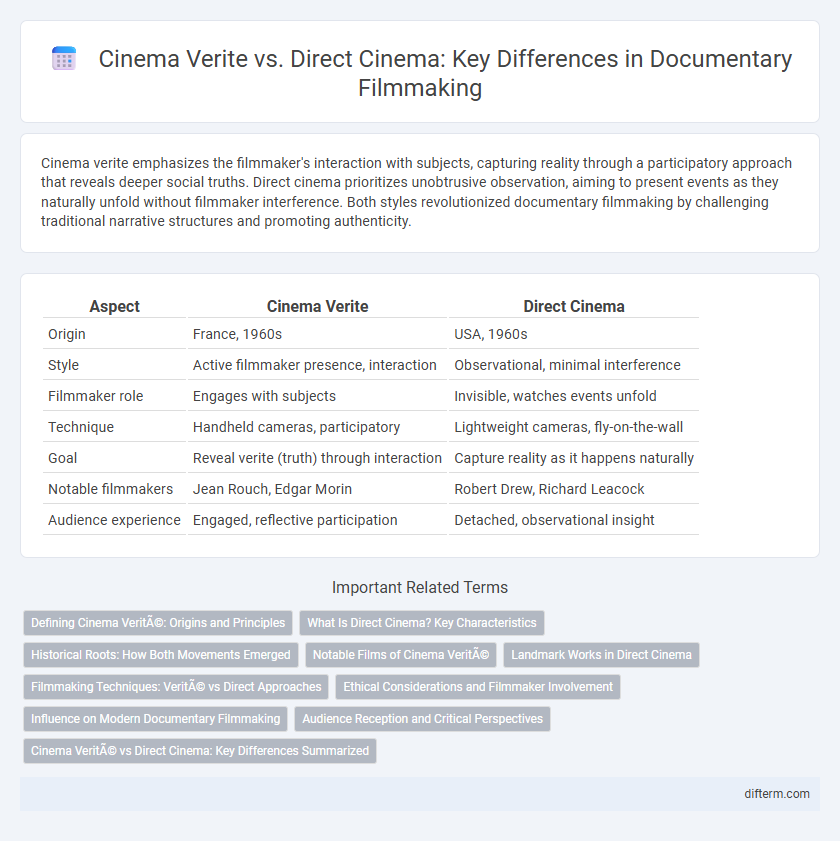Cinema verite emphasizes the filmmaker's interaction with subjects, capturing reality through a participatory approach that reveals deeper social truths. Direct cinema prioritizes unobtrusive observation, aiming to present events as they naturally unfold without filmmaker interference. Both styles revolutionized documentary filmmaking by challenging traditional narrative structures and promoting authenticity.
Table of Comparison
| Aspect | Cinema Verite | Direct Cinema |
|---|---|---|
| Origin | France, 1960s | USA, 1960s |
| Style | Active filmmaker presence, interaction | Observational, minimal interference |
| Filmmaker role | Engages with subjects | Invisible, watches events unfold |
| Technique | Handheld cameras, participatory | Lightweight cameras, fly-on-the-wall |
| Goal | Reveal verite (truth) through interaction | Capture reality as it happens naturally |
| Notable filmmakers | Jean Rouch, Edgar Morin | Robert Drew, Richard Leacock |
| Audience experience | Engaged, reflective participation | Detached, observational insight |
Defining Cinema Verité: Origins and Principles
Cinema verite originated in the 1960s as a French documentary filmmaking style emphasizing naturalistic, observational techniques combined with filmmaker interaction to reveal deeper truths. It relies on lightweight camera equipment and synchronous sound to capture real-life events authentically while allowing the filmmaker's presence to influence the narrative. Key principles include spontaneity, minimal scripting, and an intimate engagement with subjects, distinguishing it from the purely observational Direct Cinema approach.
What Is Direct Cinema? Key Characteristics
Direct Cinema is a documentary style that emerged in the 1960s, characterized by unobtrusive observation and minimal filmmaker intervention to capture reality as it unfolds. It emphasizes natural lighting, synchronous sound, and handheld cameras to create an immersive, verite-like experience. Unlike Cinema Verite, Direct Cinema avoids explicit interaction with subjects, aiming for an objective portrayal of everyday life.
Historical Roots: How Both Movements Emerged
Cinema verite and Direct cinema both emerged in the late 1950s and early 1960s as pioneering documentary styles, rooted in advancements in lightweight cameras and synchronized sound technology. Cinema verite originated in France, influenced by Jean Rouch's ethnographic films, emphasizing filmmaker interaction and reflexivity. Direct cinema developed primarily in North America, particularly Canada and the United States, focusing on unobtrusive observation to capture reality without intervention.
Notable Films of Cinema Verité
Notable films of Cinema Verite include Jean Rouch's "Chronicle of a Summer" (1961), which pioneered observational techniques combined with direct interaction, and D.A. Pennebaker's "Dont Look Back" (1967), documenting Bob Dylan's 1965 tour with an emphasis on candid, unrehearsed moments. Another significant work is Frederick Wiseman's "Titicut Follies" (1967), which exposes social issues through immersive, fly-on-the-wall footage without narration or interviews. These films exemplify Cinema Verite's blend of reality and filmmaker influence, distinguishing it from the purely observational style of Direct Cinema.
Landmark Works in Direct Cinema
Landmark works in Direct Cinema, such as Frederick Wiseman's "Titicut Follies" and the Maysles brothers' "Salesman," emphasize unobtrusive observation and capturing reality as it unfolds without interference, distinguishing it from Cinema Verite's participatory approach. Direct Cinema originated in the United States during the 1960s with the advent of lightweight cameras and synchronized sound, enabling filmmakers to record events naturally and authentically. These seminal films set new standards for documentary realism and influenced generations of filmmakers seeking to portray everyday life with minimal manipulation.
Filmmaking Techniques: Verité vs Direct Approaches
Cinema verite employs active filmmaker intervention and staged scenarios to provoke authentic reactions, using handheld cameras and synchronized sound to blend reality with narrative structure. Direct cinema emphasizes unobtrusive observation, capturing events as they naturally unfold through lightweight equipment and minimal interference, prioritizing spontaneity and truthfulness. Both techniques revolutionized documentary storytelling by balancing filmmaker presence with authentic depiction, influencing contemporary cinematic realism.
Ethical Considerations and Filmmaker Involvement
Cinema verite emphasizes active filmmaker involvement, often provoking subjects to reveal deeper truths, raising ethical questions about manipulation and authenticity. Direct cinema aims for minimal intervention, capturing reality as unobtrusively as possible, which challenges filmmakers to balance truthful representation with respect for subjects' privacy. Both styles navigate ethical dilemmas regarding consent, portrayal, and influence on real-life events within documentary filmmaking.
Influence on Modern Documentary Filmmaking
Cinema verite and Direct Cinema significantly shaped modern documentary filmmaking by emphasizing observational techniques and authenticity. Cinema verite's interactive style encourages filmmaker presence and subject engagement, while Direct Cinema strives for unobtrusive, fly-on-the-wall capture of reality. These approaches collectively influence contemporary documentaries by promoting immersion, spontaneity, and ethical representation of real-life events.
Audience Reception and Critical Perspectives
Cinema verite engages audiences through its participatory style, emphasizing the filmmaker's presence and interaction with subjects, which often leads to a heightened sense of immediacy and authenticity. Direct cinema, by contrast, adopts a more observational approach, minimizing filmmaker intervention to immerse viewers in an unobtrusive portrayal of reality, fostering a sense of objectivity and naturalism. Critics often debate the ethical implications and narrative impact of each style, with cinema verite praised for its emotional depth and direct cinema valued for its subtlety and commitment to capturing unmediated truth.
Cinema Verité vs Direct Cinema: Key Differences Summarized
Cinema Verite emphasizes the filmmaker's active involvement and interaction with subjects, often using handheld cameras and synchronous sound to capture spontaneous moments. Direct Cinema seeks to observe reality with minimal interference, presenting events as they naturally unfold through unobtrusive filming techniques. Both styles prioritize authenticity but differ in the degree of filmmaker presence and engagement during recording.
Cinema verité vs Direct cinema Infographic

 difterm.com
difterm.com